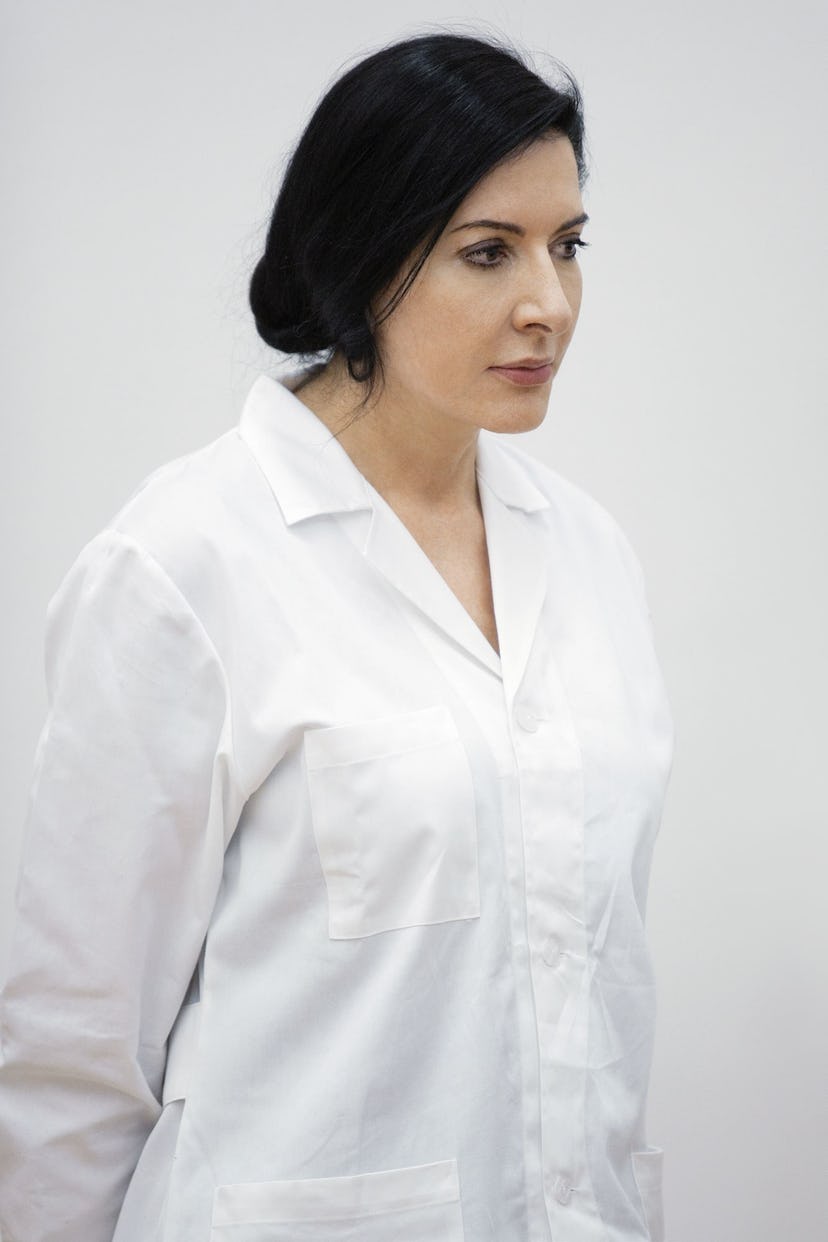Marina Abramović: Immaterial Girl
In a new performance at Sean Kelly Gallery in New York, the artist will not always be present.

Not long ago, Marina Abramović moved into a new apartment on a remote block of downtown Manhattan, at the same address as her friend Cindy Sherman. When I visited her there last week on an unexpectedly warm fall day, she led me out onto the terrace and pointed to a building that appeared no more than a block or two away. “You see that one?” she said. “I moved from there, to here.” She laughed, and the skin around her eyes and mouth crinkled. Otherwise, little of the Belgrade-born artist’s trying life—the verbally abusive mother, the heartbreaks, the years of self-inflicted pain and bloodshed in her quest to commune with her audience—told on her smooth, pale features.
“You know, I’m going to be 68 next month,” Abramović said once we retreated inside. She delivered this news joyously—as if to say, How did I make it this far!—while she acted the cheery hostess. It might have been a little jarring to observe Abramović, whose statuesque stoicism is a constant of her performances, bustling animatedly about her kitchen had she not been slicing wedges of lemon for a glass of water, which reminded me of the time she told The New Yorker, “All the aggressive actions I do to myself I would never dream of doing in my own life—I am not this kind of person. I cry if I cut myself peeling potatoes.”
Abramović took a seat on her new sofa, a Patricia Urquiola design padded with goose feathers. (“It’s hard to find a good sofa,” she noted. “I used to have a Ron Arad Misfit”—modular seating that brings to mind an obstacle course—“and nobody wanted to sit on it.”) She patted the spot next to her invitingly, and went on: “I look back at my career and I think, ‘I’ve done too much,’” she confessed. “I feel old only when I look back. So I’ve got to keep moving, otherwise …” She trailed off with a low chuckle.
In the mornings, Abramović trains with her kick-boxing coach, whom she opts to meet at six-thirty—“because then I can’t tell him I am doing anything else,” she said. “The trainer, he kills me.” The woman who endured more than 700 motionless hours in the MoMA atrium moaned conspiratorially. (Performance artists, they’re just like us.)
The training is not meant to steel her for Generator, her new exhibition opening Thursday, October 23 at Sean Kelly Gallery in Chelsea. Her first New York solo show since The Artist Is Present made her a celebrity won’t exact nearly the same toll as the 2010 MoMA show. (It took Abramović three years to recover from the mental and physical strain of that three-month performance.) The engine of the exhibition will not be Abramović’s body, as the case has been so often in her career, but her audience: Upon arrival, visitors will hand over their cell phones and bags before donning noise-canceling headphones and blindfolds. In effect, the gallery will become a sensory-deprivation chamber, in which one can move about as they like, physically engaging with strangers if they wish.
“Ten years ago, this kind of project is not possible,” Abramović explained. “Now it is, because human beings need so much to be with themselves, especially in New York, where everything is so much about audio and visual consumption.” The concept is an elegant distillation of 512 Hours, her performance at the Serpentine Gallery in London this summer, where she also used headphones and blindfolds, but in combination with other props and activities, which she has done away with at Sean Kelly.
Some of Abramović’s most affecting work has been her humblest. Laying down in the middle of a flaming star, as she did in 1974, produced great drama and a memorable image, but over the years she has kept refining her work, until you get, in her masterful MoMA performance, a piece that consists of two wooden chairs and time. (Originally, her concept involved scaffolding and elaborate props, but in the end she opted for simplicity.) “There’s nothing to it,” she said of Generator. “It’s extremely simple, but something different. My work is getting more and more immaterial.”
By turning the focus away from herself to her audience, Abramović, who calls herself the grandmother of performance art, is also preparing a new generation to carry on her legacy. “It’s like putting a key into a generator,” she explained. “And then seeing if the generator can work without you. I do not have to be there the whole time.”
But it does not appear she is going away anytime soon. The picture of vitality, Abramović, who was recently named number one on Artnet’s list of “100 Most Powerful Women In Art,” is still capable of glamorous showmanship. She led me to her walk-in closet, where she keeps some of the costumes and elaborate pieces created for her by her close friend Riccardo Tisci, the creative director of Givenchy. “This is mostly from Riccardo,” she said, peeking inside. “I haven’t bought clothes in six years.” Some of the pieces were from the staging of The Life and Death of Marina Abramović, on which she collaborated with Robert Wilson last year at the Park Avenue Armory.
Abramović has long stated that her last act will be her death: three coffins, in three cities (Belgrade, Amsterdam, and New York), with each funeral happening at the same time—“we won’t know which Marina is the right one,” she said. Then she added, “I think turning myself into ashes is a selfish thing. I’d like other creatures to benefit from me. I love the worms eating me; I love the tree that comes out of my body.” She smiled. “And maybe I come up again, through the leaves.”